5.7: Young British Artists (1980-2000)
- Last updated
- Save as PDF
- Page ID
- 174441
Introduction
In 1988, a group of young artists in Britain held two pop-up exhibits, Freeze in 1988 and Sensation in 1997. The art was different from the traditional, as artists used unusual materials and sometimes shocking images. The art was distinctive, almost notorious, and the artists earned the name, Young British Artists. The negative coverage by the English press gained them publicity. Many artists attended or graduated from Goldsmiths College of Art in London, including Damien Hirst, one of the most well-known. The school helped develop the movement and cultivated new art forms by abolishing the typical separation of painting, printmaking, sculpture, or other art methods. They encouraged students to combine concepts for new themes in mixed studios and be more entrepreneurial in marketing and showing artwork.
Stylistically, the artists used ideas from Minimalism and Conceptualism; however, they frequently incorporated the darker properties of modern life. Each artist developed a different approach. Some artists used found materials; others employed video, film, printmaking, paint, or photography, and others fashioned extensive installations. The Young British Artists have used appropriated objects, dead animals, furniture from their house, food, cement blocks, cigarettes, or other material. There were no limits or parameters they had to follow; the artists were open to developing a process and selecting objects that may be shocking or challenging. The artists developed a reputation for doing whatever they wanted with whatever material they chose, which was not always an acceptable idea to many in the art world.
Damien Hirst was considered the de facto leader of the inventive artistic concepts, his unusual sculpture of the shark winning him publicity and awards. Most artists were in their twenties and recognized the opportunity to bring change to the stagnant English art market, each with different ideas. The Tate Modern Gallery was also part of the sensational acceptance of the new art forms. London had no modern art public museum, and private donors supported the funds to acquire contemporary modern art and build a gallery. The Young British Artists were a significant part of the move to modernity.
Damien Hirst
Damien Hirst (1965-) was born in England, studied art, and then attended Jacob Kramer College. After employment on building sites for two years, he went to Goldsmiths College. While he was at Goldsmiths, Hirst worked in a mortuary, influencing his future concepts. At the college, he was the main organizer of the student exhibition and the new revolutionary ideas of art. One of the most symbolic representations of the Young British Artists is Hirst's shark. Entitled The Physical Impossibility of Death in the Mind of Someone Living (7.7.1), the shark is suspended in formaldehyde. The shark appears alive, yet everyone knows it is dead. The image was known for its shock value and reaction of a viewer to the symbol of death. The original shark was purchased at a high price by a collector, and when the shark began to deteriorate, the collector paid for a replacement. This led to the argument – was it still the same artwork or something new – upsetting the concept of art conservation.
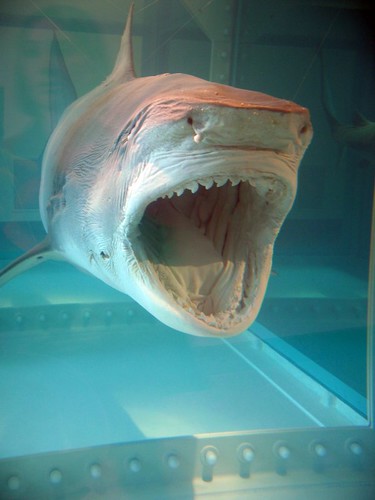
Away from the Flock (7.7.2) is another sculpture composed of a glass-walled tank and a dead sheep in formaldehyde solution. The sheep is positioned to seem it is still alive. Hirst made different versions of the sculpture with distinctive sheep posed in various positions, all dead but seemingly moving. The sheep and shark were part of Hirst's show, with animals, fish, and insects encased in tanks or boxes.
Hirst has generated a significant amount of criticism for the number of dead animals he has used in his work, including animal rights groups. Artnet News performed a study on Hirst's use of animals and found Hirst used thirty-six different farm animals: sheep, horses, cows, pigs, and even one bear and one zebra. In the category of fish, Hirst used seventeen sharks and 668 other fish. Hirst also added thousands of different insects to his art, including 17,000 butterflies, 45,000 insects from 3,000 species, and five birds.[1]
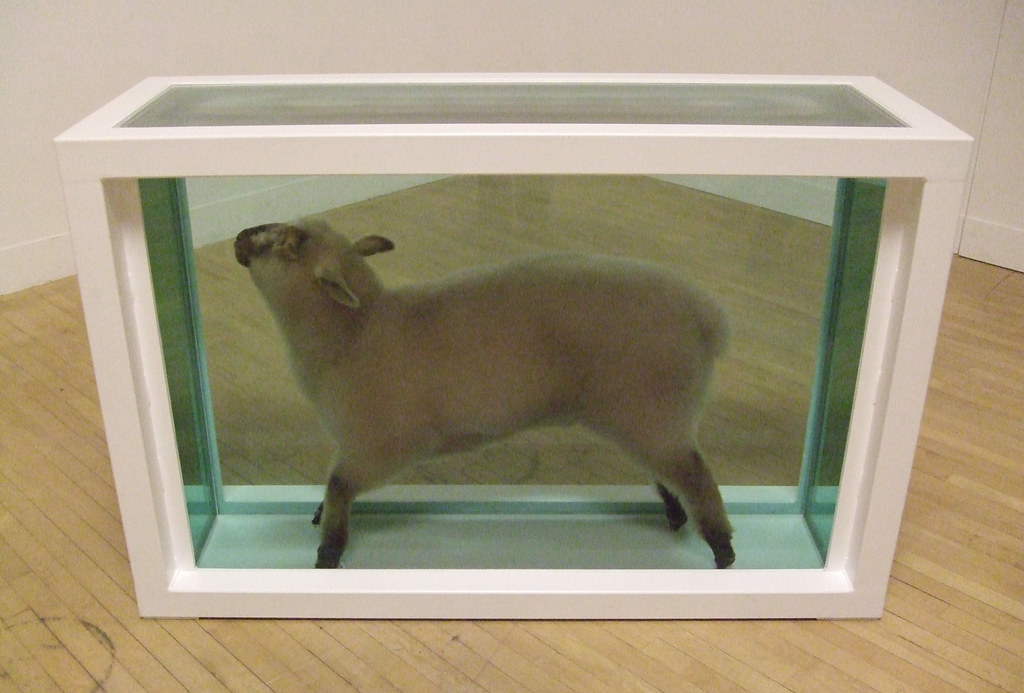
Hirst made the immense six-meter-tall painted bronze statue, Hymn (7.7.3), created after the anatomical toy he purchased for his son. Hirst loved the way all the body parts fit together; the colors of the parts allowed each distinct element to stand out. However, Hirst made his sculpture precisely like the toy he bought, created for the Young Scientist Anatomy set. Although he did scale the image larger and changed from the toy's plastic to bronze, Hirst was accused of plagiarism and had to pay a settlement to the toy company. The title Hymn is a play on the word 'him.' The statue is reminiscent of the Greek sculptures, arms close to the body with a naked form demonstrating the beauty of the body. The Greeks also favored using bronze and placing lead weights in the feet for stability, just as Hirst used bronze.
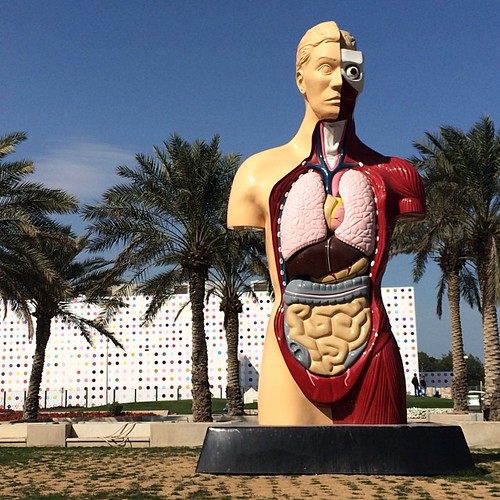
Hirst generally used repetition in his work and created a series of any of his themes. Hirst stated,
"People are afraid of change, so you create a kind of belief for them through repetition. It's like breathing. I've always been drawn to series and pairs. A unique thing is quite a frightening object."[2]
He painted over one thousand Spot paintings like Dantrolene (7.7.4) with multicolored spots. Hirst used white backgrounds and painted the spots by hand using shiny house paint. He wanted the spots to look as though a machine applied them; only subtle blemishes reflect the use of an artist's hand. Hirst's Spot series at times appear calming or unnerving, presenting the viewer with a visual dichotomy. Hirst named his Spot series after pharmaceuticals. Dantrolene was a muscle relaxer used to treat muscle spasms or stiffness. Hirst started making a series of Pill Cabinets filled with pharmaceutical and medical bottles and jars. Carefully arranged, most of the bottles had their warning labels exposed.
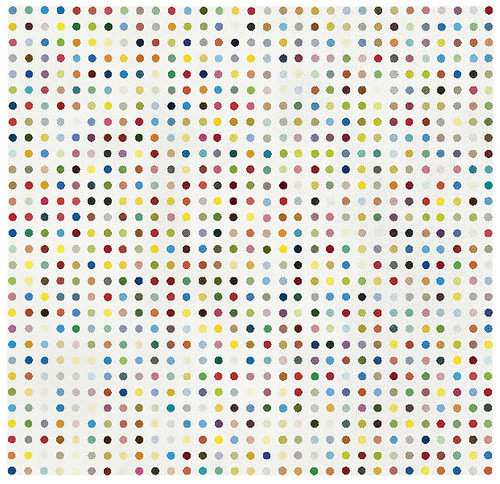
Pretty Vacant (7.7.5) is one of his cabinets, mounted on the wall and filled with items Hirst bought from stores. The series turns viewers into voyeurs as they appear to be looking into a person's private medicines, our medicines a very personal concept, especially addictive pills. In the series, Hirst examines society's belief in drugs as a cure-all. The success of the different medicine cabinets led to his installation of a complete pharmacy.

Tracey Emin
Tracey Emin (1963-) was born in London. Her father was a Turkish Cypriot, and her mother from Romanian descent. She studied fashion design and printing at different colleges before receiving a master's degree in painting from the Royal College of Art. Unfortunately, Emin was raped when she was only thirteen, something she said was all too familiar in her neighborhood. The tragedy significantly influenced her work, and she is known for her autobiographical and confessional style of art. Emin works in multiple types of media, sculpture, film, paint, photography, and others. One of her first significant exhibitions was about her bed, bringing her major recognition.
For her installation of My Bed (7.7.6), Emin took the bed from her room, along with all the detritus surrounding it, and installed it in the gallery. Emin stated the space was an accurate reconstruction of her room after she became depressed. She spent weeks in bed drinking, smoking, having sexual relationships, or eating, all to deal with her emotional distress. Strewn around the bed, Emin included used condoms, dirty underwear, stained sheets, old Kleenex, and cigarette butts.[3] She termed this confessional art, revealing potentially embarrassing parts of her life. The press and critics were in an uproar declaring the installation was not art. Others thought of the bed as a definition of the boundaries of a young woman.

Psyco Slut (7.7.7) was made on a blanket. Emin appliqued different words and phrases on patches of text she wrote by hand. The blanket became a history of Emin's life in intimate detail. She inscribed her childhood abuse and the pain of an abortion. Emin made other blankets from fabrics she felt brought her comfort, including her clothing, the clothes of her parents, and other scraps found around the house. Emin made multiple digital neon art of her poetic thoughts. She wrote about the tensions of relationships and how the interdependencies affect a person's vulnerability or feelings of empowerment.
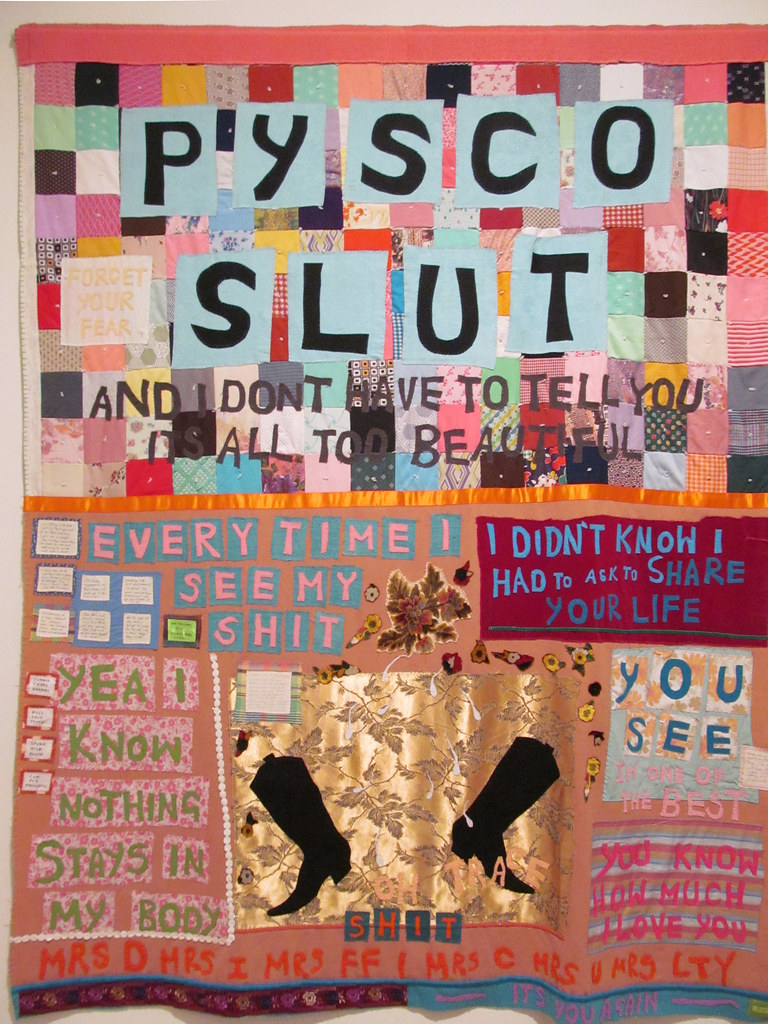
Fantastic to Feel Beautiful Again (7.7.8) demonstrates her recovery from a poor relationship. All her sayings reflected her open feelings, sometimes playful or other times confrontational and constantly thought-provoking.

Sarah Lucas
Sarah Lucas (1962-) was one of the later members of the Young British Artists recognized in the 1990s for her extraordinary subject matter. Her work was sexual and blurred masculinity and femininity; Lucas declared she liked androgyny. She was born in London and studied art at different colleges before graduating from Goldsmiths College with her degree in Fine Art. Lucas' work was part of the early Freeze exhibition and was considered one of the more shocking members of the group. She experimented with materials and images, including making a toilet with cigarettes. Lucas used found materials she manipulated and altered. She applied some of the odder materials like fruit or vegetables to portray body parts. Lucas' work was based on everyday objects to depict her exploration of sexual ambiguity and how something familiar or strange brings a disorienting tension.
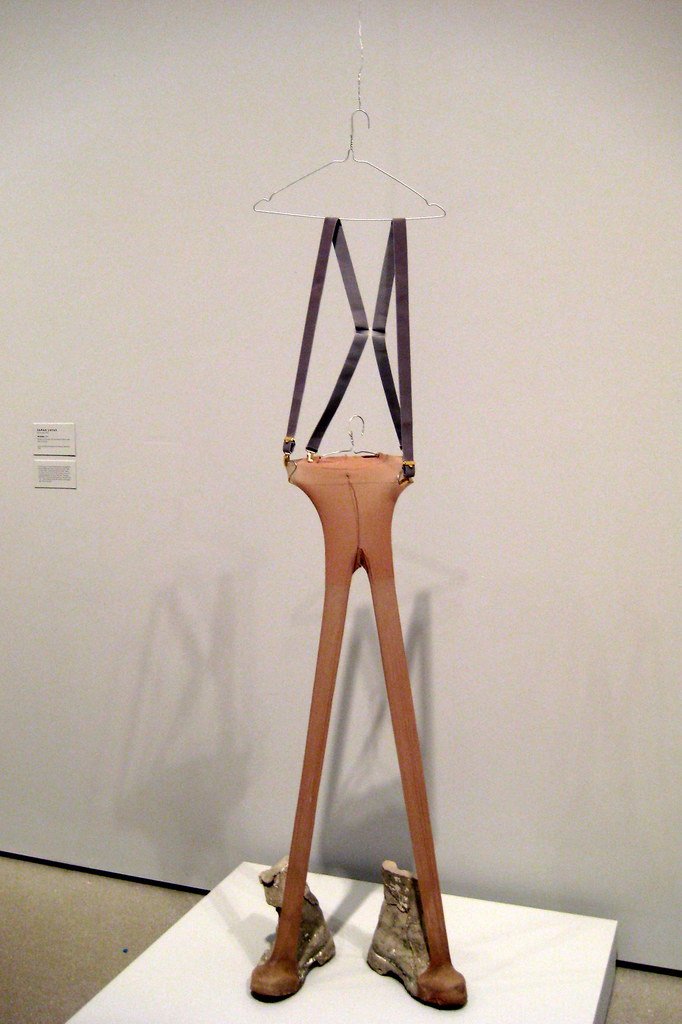
Lucas stuffed nylon stockings to form the body of the soldier in her sculpture, Oh! Soldier (7.7.9). Old used suspenders form the top of the body as the legs are set in army boots, she cast from concrete. Two coat hangers help hold the shapes in place. Automatically, the soldier is perceived to be a male, a reaction to the title of the work and the heavy boots. However, the body is made from tights worn by women, making this sculpture open for sexual interpretation. Titti Doris (7.7.10) is made from tights stuffed with fluff and slouched in a chair. The figure demonstrates and focuses on the objectification of female breasts, a cluster of saggy shapes mounded like a pile of melons—each oversized shape announcing its right to exist.
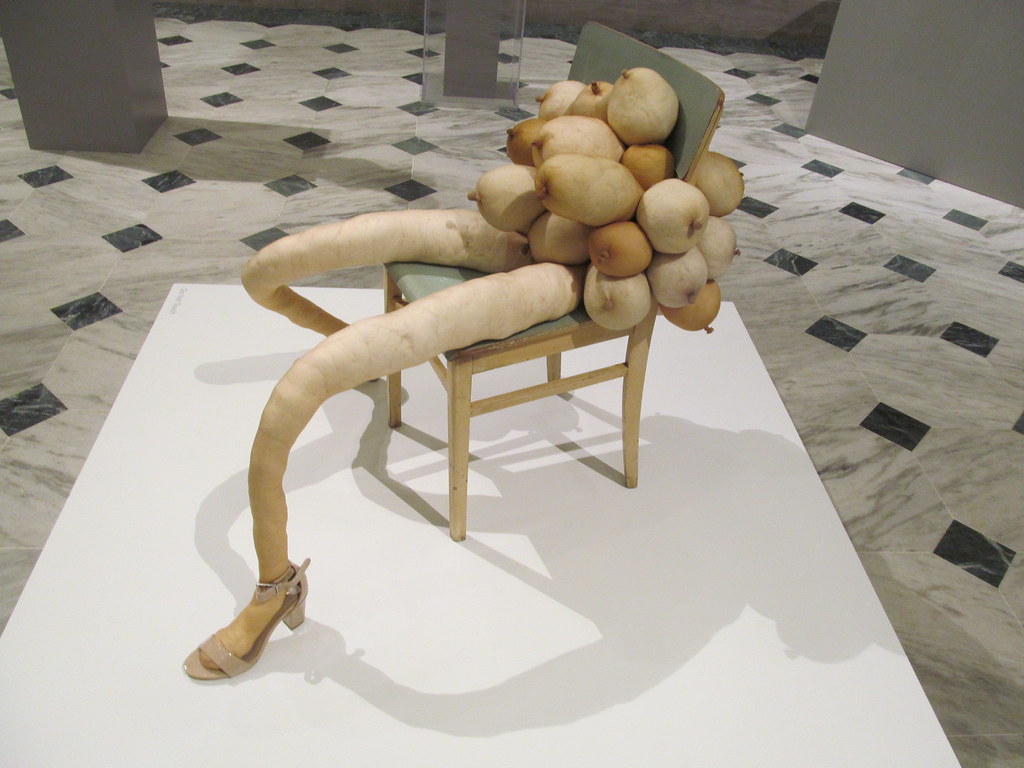
Anya Gallaccio
Anya Gallaccio (1963-) was born in Scotland, where her father was a TV producer and her mother an actress. Gallaccio attended Goldsmiths College and was part of the Young British Artists Freeze exhibition. She created installations based on organic materials that transform and decay into unpredictable artwork. Because she uses objects like flowers, ice, sugar, trees, or other natural material, the materials may smell good or be exceptionally colorful when first established. The elements may melt, wilt, collapse, or decay from their biological processes as time passes. Gallaccio referred to her artwork as performance because activity occurred, even slowly. One of her installations included assembling a ton of oranges over the floor and watching the natural progression of decay, the performance of nature interacting with the oranges.
In her installation, The Light Pours Out of Me (7.7.11), Gallaccio said, "I would like it to be unsettling for people when they first encounter it. I'd like them to question whether they should enter the gate or not. Then, when they come into the space, it is very formal, quite grandiose but intimate, a quiet place for one or two people."[4] Gallaccio wanted viewers to see the artwork personally and up close. She created a grotto like those found in older English landscapes.

The walls (7.7.12) ripple with amethyst and groups of crystals, all appearing smooth yet dangerously jagged.

At the bottom lays a small pool of water (7.7.13) from black obsidian stone. The installation changes by season, rainfall, vegetation growth, or even as people remove small pieces of stone. Gallaccio imagined the installation would change over geological time instead of human time.

Gallaccio's installation of Red on Green (7.7.14) was composed of 10,000 red roses laid like a carpet across the gallery floor. Initially, the roses were bright red, soft, and emitting the voluptuous aroma of roses. However, the thorns were still on the stems, dangerous to carelessly walk across the floor or pick a handful of blooms. The roses began to decay over a relatively short time (7.7.15) until they turned moldy and dark. The roses transform from beauty and romance to ugly and decayed.
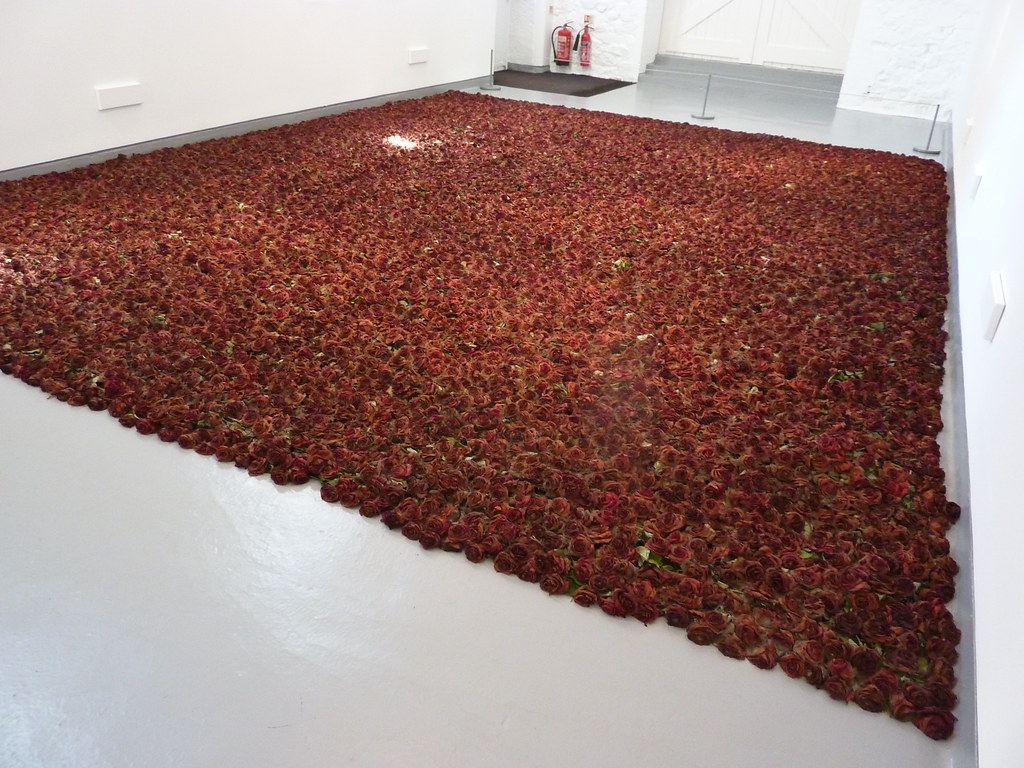
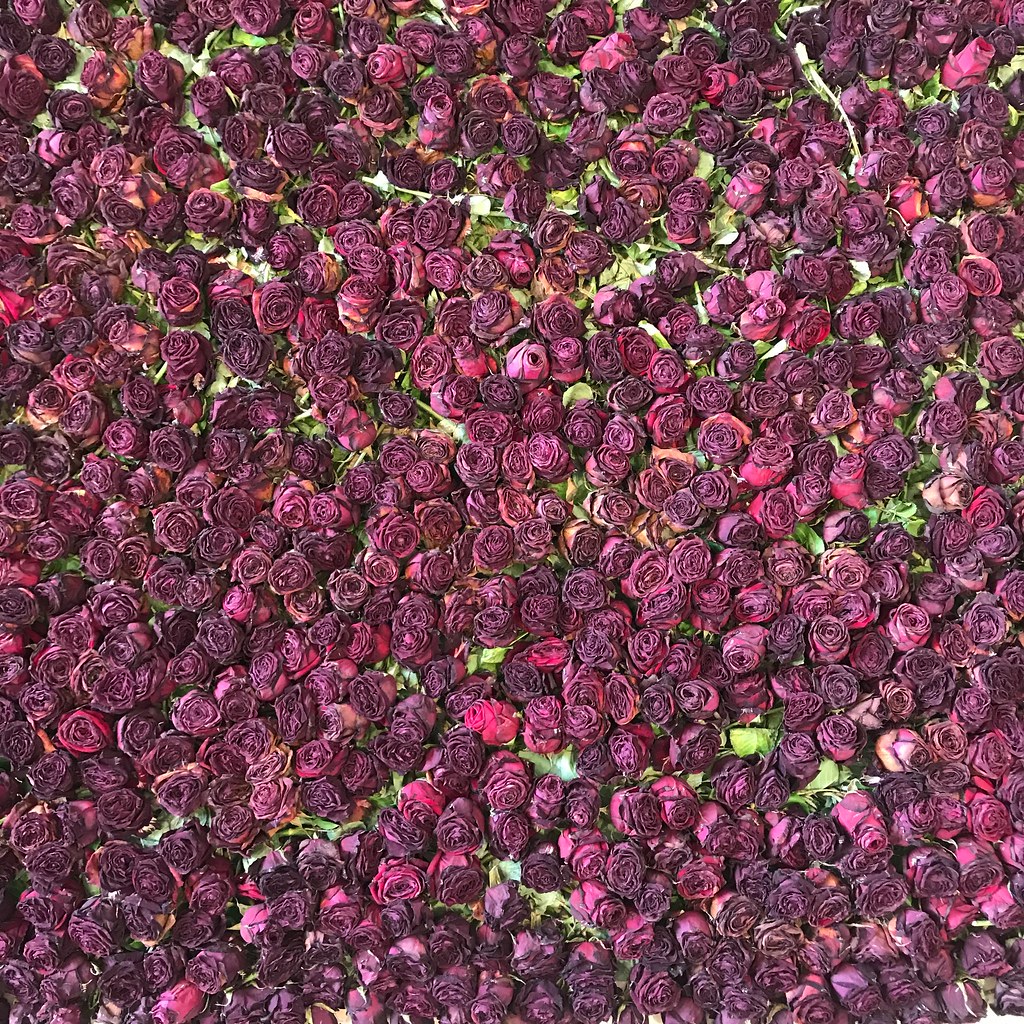
Angus Fairhurst
Born in England, Angus Fairhurst (1966-2008) graduated from Goldsmiths College in Fine Art at the same time as Damien Hirst. Fairhurst and Hirst became friends and collaborated on multiple projects. Fairhurst worked in different media; his work included practical jokes and distorted or exaggerated visuals. He was well-known for his bronze gorilla sculptures in unusual portrayals. Fairhurst was described as brilliant, witty, and intensely intelligent. Sadly, at the age of forty-one, he committed suicide. Damien Hirst said, "He was a great artist and a great friend, he always supported me in fair weather and foul. He shone like the moon and as an artist he had just the right amount of slightly-round-the-bend. I loved him."[5] A Couple of Differences Between Thinking and Feeling I (7.7.16) depicts the odd combination of the oversized gorilla holding a fish under its arm. The giant gorilla appears to be looking into the distance with little emotion. The statue is posed in a full-frontal view.
The immense gorilla in A Couple of Differences Between Thinking and Feeling II (7.7.17) stands on his legs and one arm as it stares at his left arm lying on the floor in front of him. The statues display Fairhurst's practice of working with the thinking and feeling or the sublime and absurd. Fairhurst made multiple drawings of different gorilla statue ideas, playing with the absurd and comic.

Fairhurst's Underdone/Overdone (7.7.18) is composed of a set of thirty paintings. He used black and white photos of the forest. He overlaid the different images and branches with primary colors, crisscrossing each other to create a thicket of trees.
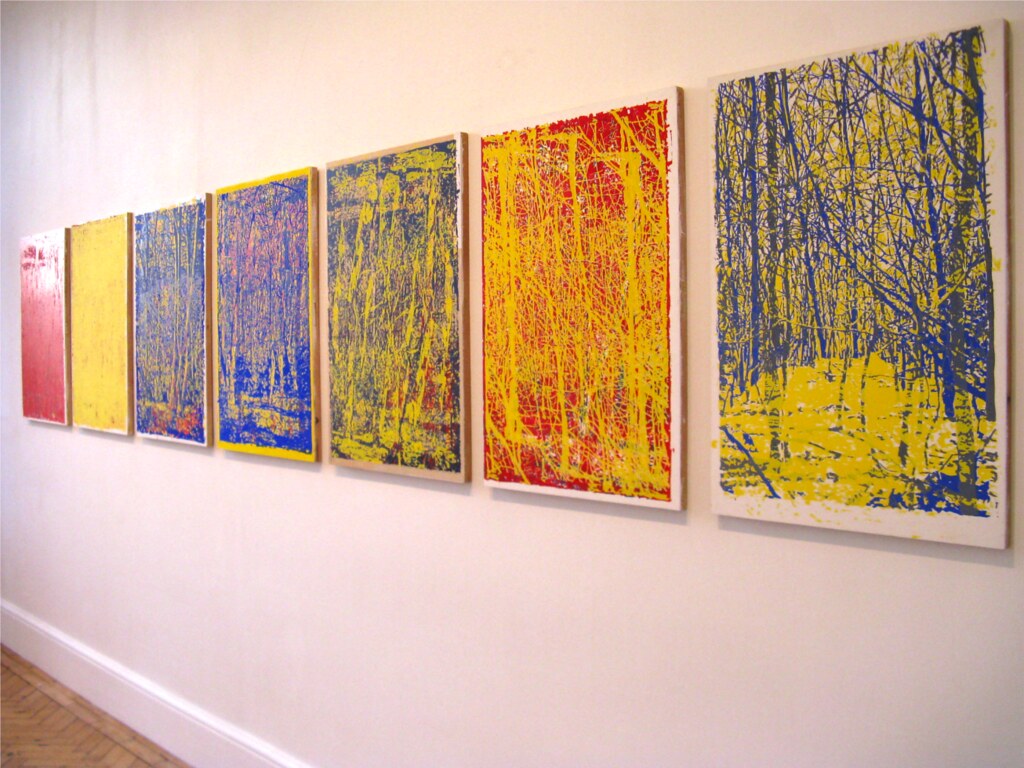
The first image (7.7.19) used a single color with a few branches overlapping. Each image in the line became more abstracted as the layers developed, more branches were added, and the panels at the end of the line became a mass of color. Fairhurst changed the known at the beginning to the unrecognizable at the finale. He explored the boundaries and an antithesis of the formed becoming formless. The subject matter of trees reveals Fairhurst's love of the outdoors as he spent much of his time exploring the Scottish Highlands. Unfortunately, the same woods are where Fairhurst took his life.
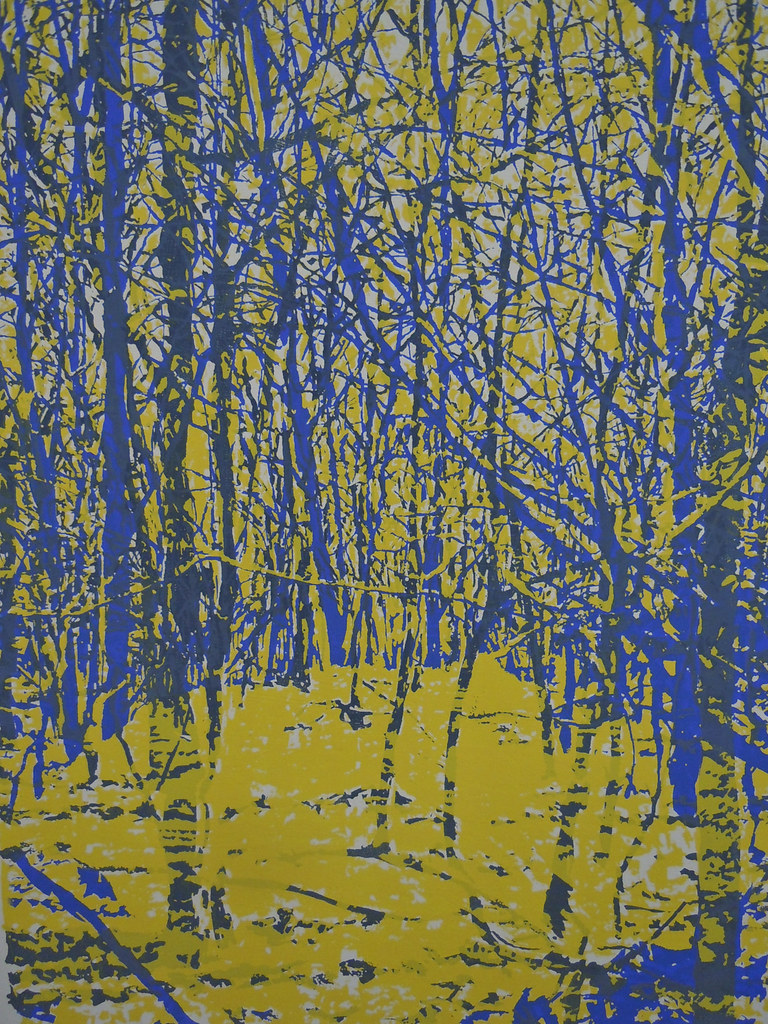
Jenny Saville
Born in England, Jenny Saville (1970-) received a degree from Glasgow School of Art and went to the United States to study at the University of Cincinnati. Saville took a women's study class at the university and was exposed to different political and feminist views. While in Ohio, she observed, "You saw lots of big women. Big white flesh in shorts and T-shirts, all of whom had the physicality that I was interested in."[6] Saville also went to New York and watched a plastic surgeon work, helping her understand the anatomical shapes and formations of extreme human bodies. The images and her studies influenced Saville's unashamedly feminist artwork of large or obese women. Her first show in England was successful, and the gallery began to show her work with the other Young British Artists. Saville's paintings were larger than life-sized, and the skin highly marked and distorted. Her paintings illustrate the voluminous body, unable to hide the distorted proportions. Propped (7.7.20) was an early image, the oversized nude woman with her head tossed backward. Her eyes are closed as her hands claw her large thighs as though her thoughts are painful. The woman appears to be repulsed by her image, hiding from the disdain of the male gaze. Saville applied the paint in thick layers, becoming visceral flesh, generating an emotional response.
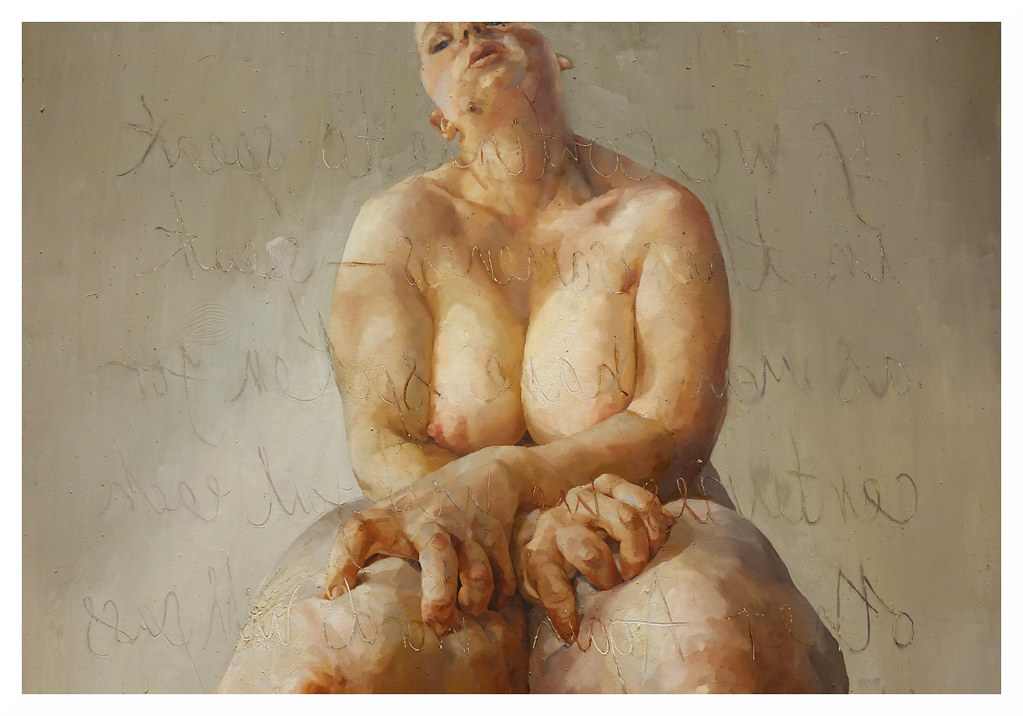
Saville was a master of the constructs of the body. She demonstrates how flesh flows and rolls upon itself, how excess skin drapes and causes different shadows. Saville paints the body as a complete entity and how its stretches in one place and falls in another. In Strategy (7.7.21), Saville depicts the same women in different positions. She painted the person as viewed from the ground exaggerating the size of her thighs and stomach, the upward angle in the massive painting dwarfing the viewer. The dimpled flesh has overtones of grays portraying the flesh as sickly and bruised. The image is not the idealized person and view generally expected in paintings; instead, the viewer is uncomfortable with the images because it does not meet the standard, flawless feminine body. Saville also painted a series of large-scale works portraying heads.

Rosetta II (7.7.22) and Bleach (7.7.23) are two of the paintings in the series. Both images demand the viewer's gaze, unable to look away. The women do not have smooth, silky skin seen in advertisements, movies, or other media. They carry the marks and scars obtained over years of society's subjective actions against women. The woman in Rosetta II is blind; her eyes are seemingly like globes, her head positioned like many of the religious images of suffering. Bleach looks directly back at the viewer, her mouth seeming swollen on the marked face. Saville was interested in how image-conscious people in the country were, these women not meeting the proper image of the plastic surgery population.
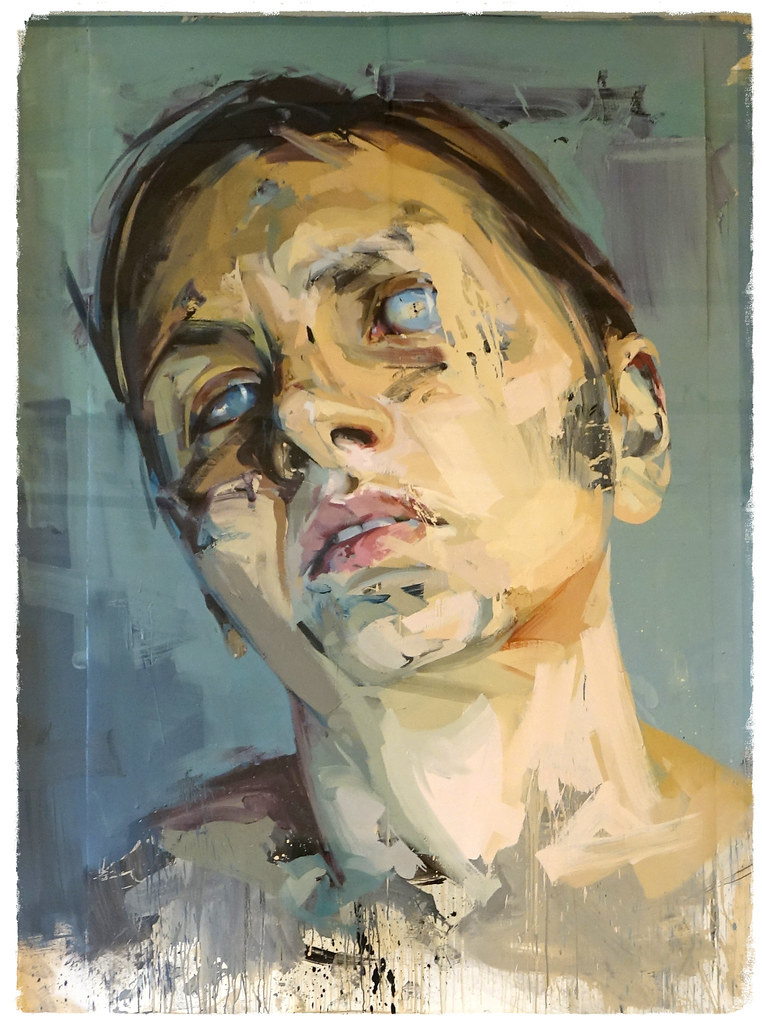
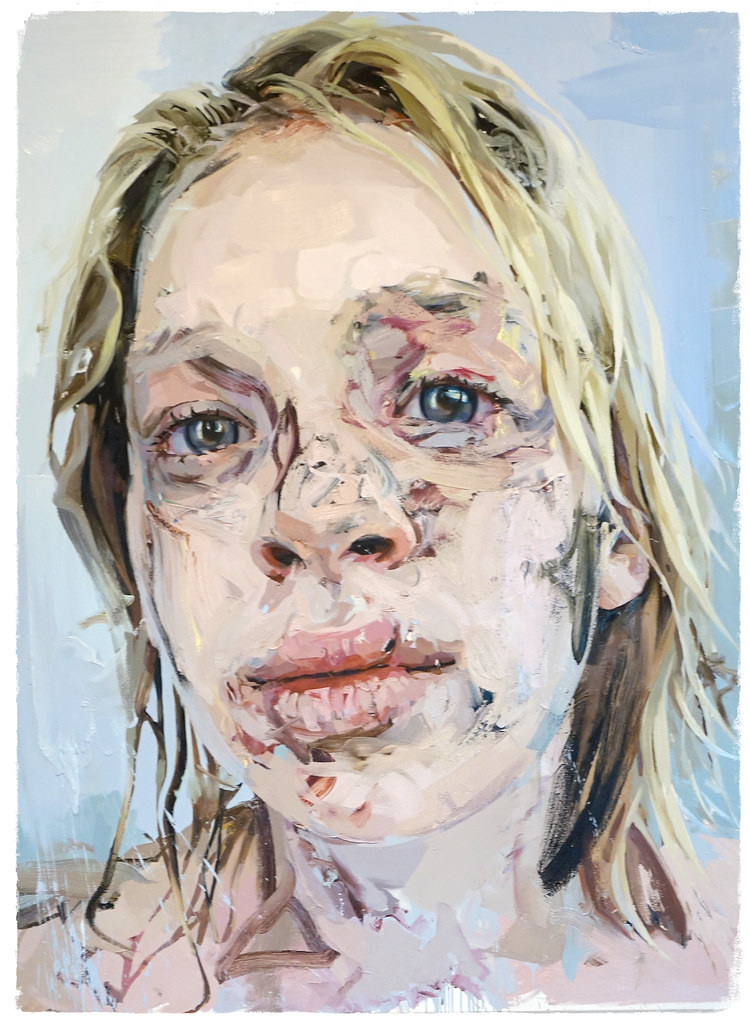
Michael Landy
Michael Landy (1963-) was from London and attended Goldsmiths College. He was part of the Freeze exhibition Damien Hirst organized and became one of the Young British Artists. As an artist, Landy frequently focused on consumerism and its effects on society. One of his shows, Break Down, was an exhibit of all the possessions he destroyed. Landy recognized all artists are not successful with everything they make, and he decided to create a mammoth structure in a South London gallery, a container to hold discarded artwork. He planned to have the structure filled with creative failures. The growing discards may have looked like a pile of junk; however, one could still identify parts of well-known artists. Art students and collectors were invited to add to the bin, a popular activity. The Art Bin (7.7.24) demonstrated how much work artists had to create to achieve success; no matter how famous the artist became, they still had failures. Landy stated, "Nobody discards art which has some sort of intrinsic value, so the bin becomes a monument to creative failure."[7]
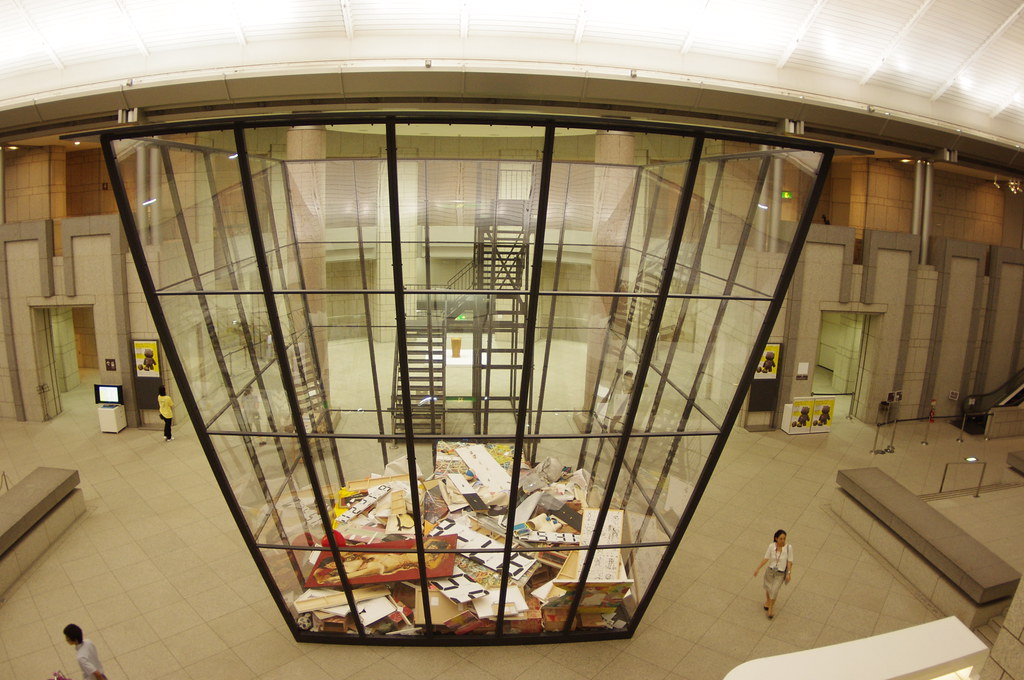
Landy's exhibition, Saints Alive, was composed of seven different kinetic sculptures that moved according to operations by the visitors. The sculptures were based on old paintings or images of religious saints from the past. Landy made cast statues and combined them with an array of assemblages from recycled materials, including toys, junk, and machinery. In the exhibition, he hung the original inspirational portraits by the statues. Landy wanted the exhibit to be interactive with the viewers while including a critique of the representative saint. One of the first statues in the exhibition was Saint Apollonia (7.7.25), dressed in Renaissance clothing. The space in her torso revealed a congregation of wheels and gears, a set of pincers in her hand. As part of her martyrdom for sainthood, her teeth were all pulled out. In the exhibit, the viewer can press a button and watch the pincers hit her face. Her face became significantly scarred as Landy structured Saint Apollonia to eventually deface herself.
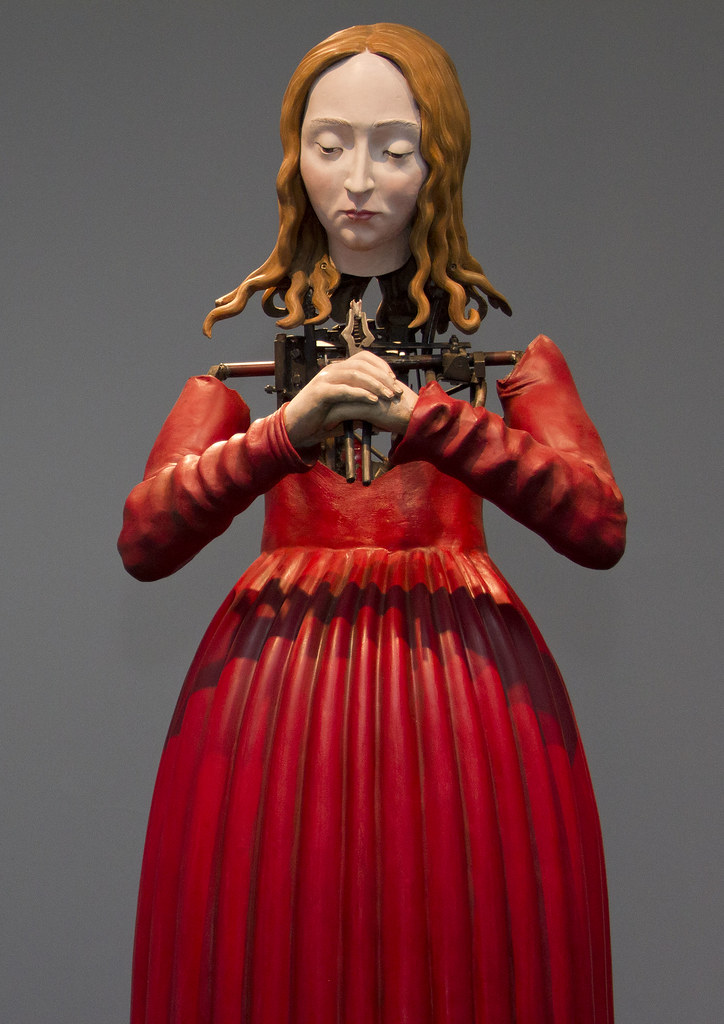
Saint Francis Lucky Dip (7.7.26) was an image of Saint Francis of Assisi, who wore a brown tunic and was barefoot. The statue is headless and hollow. Landy constructed a push-button for the viewer to drop a grabbing claw into the hollow space. Occasionally, the claw grasped a T-shirt printed with 'Poverty-Chasity-Obedience. Landy referred to Saint Francis, who took a vow of poverty and gave away all his worldly possessions.
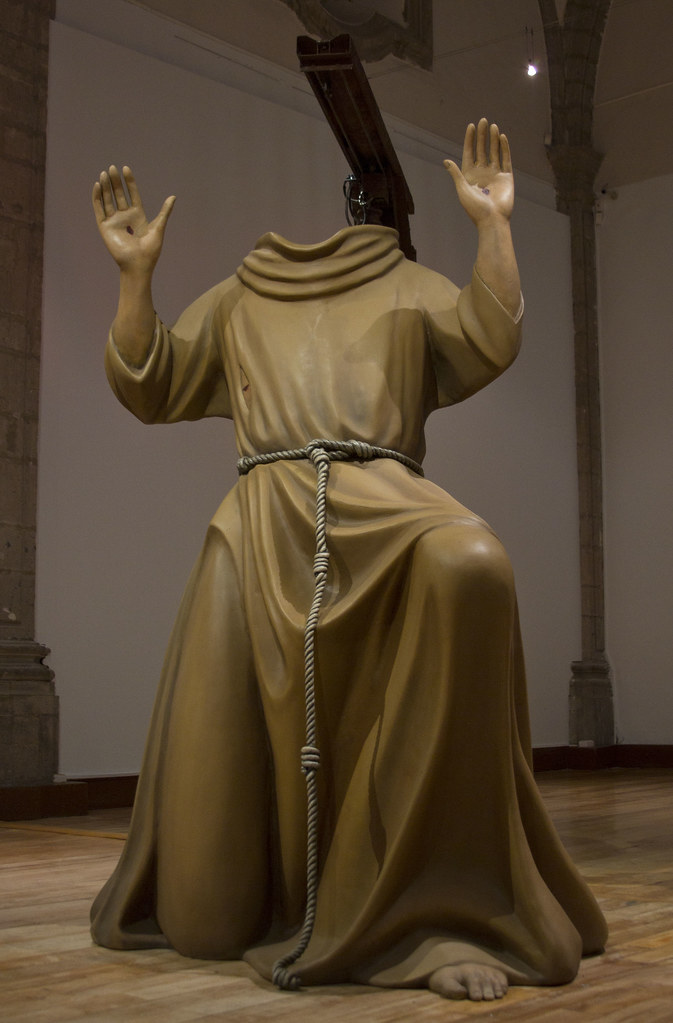
Chris Ofili
Chris Ofili (1968-) was born in England. His father went back to Nigeria when Ofili was only eleven. Ofili finished his foundation course at one college and then went to London to study at the Chelsea School of Art and the Royal College of Art. When he attended a workshop in Port of Spain, Trinidad, he decided to move there permanently. Ofili also maintains a residence and studio in London and Brooklyn. Some of the Neo-expressionists were very influential on Ofili, especially Jean-Michel Basquiat and Georg Baselitz. Intricate paintings with kaleidoscopic designs were the style Ofili used to create figurative yet abstract images. His work is vibrant, colorful, and multi-layered; the materials he uses are unusual including, glitter, resin, beads, and even elephant dung.
Ofili wanted his work to convey black culture and history while maintaining a feeling of exoticism. No Woman, No Cry (7.7.27) depicts a woman crying oversized tears. The yellow background is patterned with a thin brown line and brown circles. Ofili used phosphorescent paint as a layer for the background, and when the woman was painted, he used oil paint thinned with turpentine to achieve a translucent look. The woman is positioned on top of the background showing through. Her bright blue eye shadow and red lipstick stand out against her dark skin. Her narrow black necklace has a lump of elephant dung for the pendant. Each tear descending from her eyes contains a photograph of a young boy's face, demonstrating her sadness over the boy's loss. The death of a teenage boy influenced Ofili during a racist assault in London. The image in the tears was a photo of the young boy.
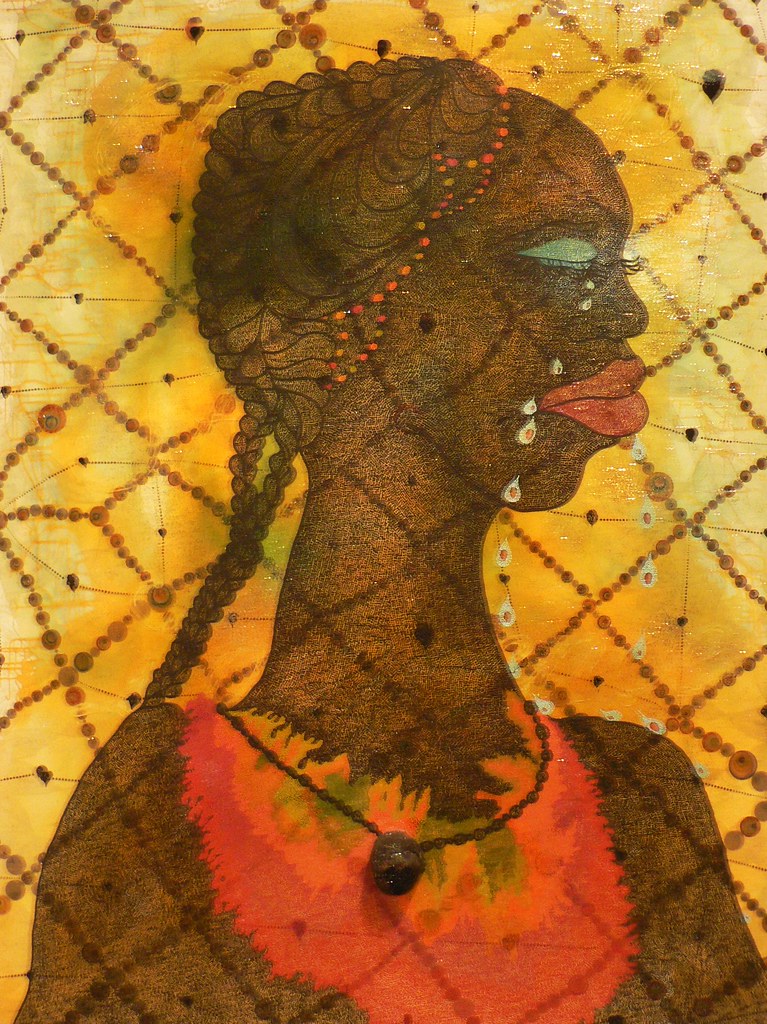
Princess of the Posse (7.7.28) was based on the battle to define one's identity, primarily through race and gender. Ofili used a wide variety of materials, built-in multiple layers as he painted and scraped. As in other paintings, he used the background as part of the complete image as the woman's clothing follows the same pattern. Ofili used acrylic paint, resin, bits of paper, map pins, and elephant poop.
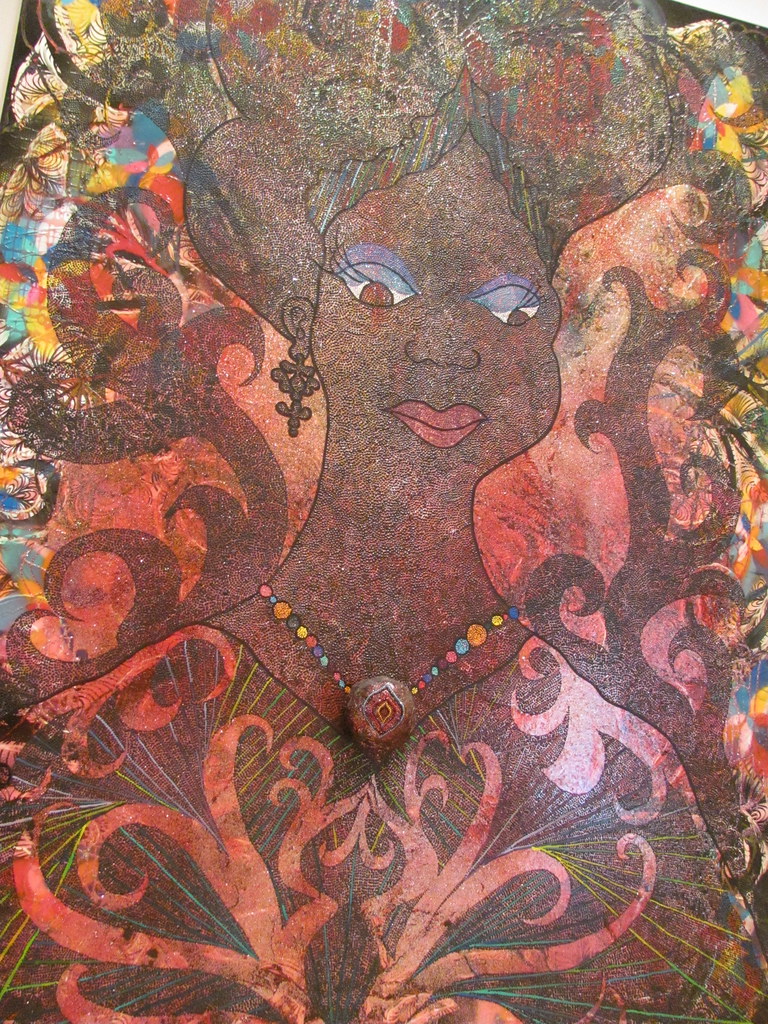
He formed the elephant poop into a ball, painted it, and then attached it to the painting as the pendant (7.7.29) on her necklace with map pins. He also used large balls of elephant poop to hold the painting off the ground during the exhibition. At the time of the show in the Brooklyn Museum, the city's mayor tried to sue the museum for exhibiting Ofili's work. The mayor declared the work as "horrible and disgusting,"[8] The mayor lost and Ofili had a lot of publicity.
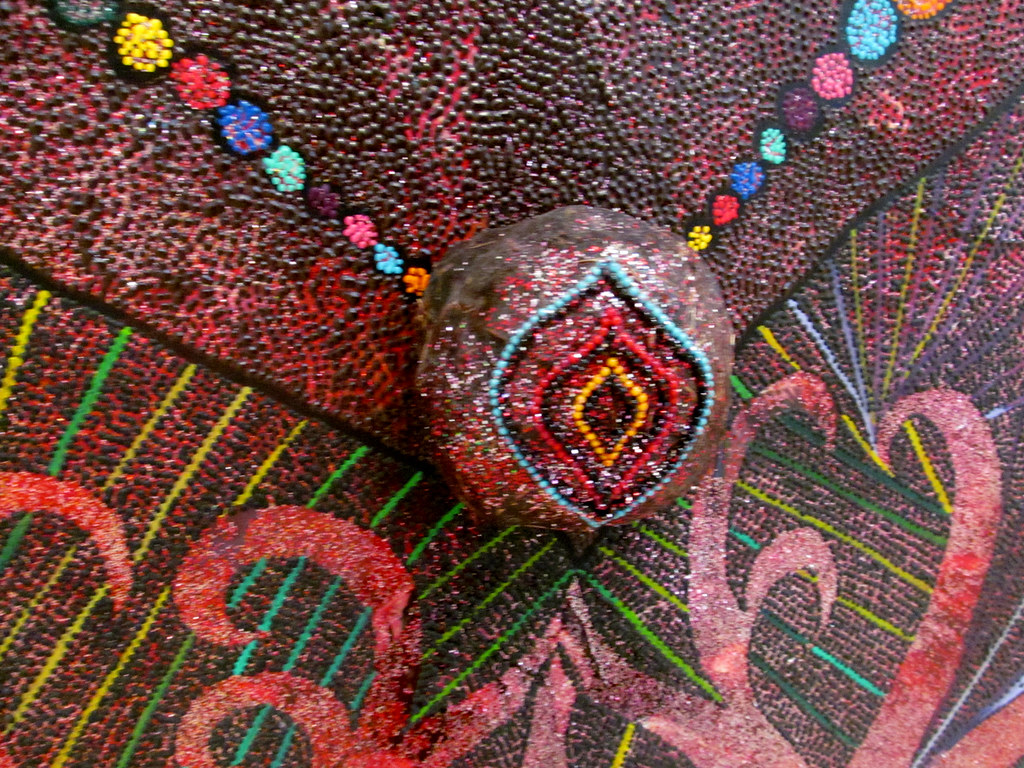
Gary Hume
Born in Kent, England, Gary Hume (1962-) graduated from Goldsmiths College, where he attended with the other Young British Artists and was part of the Freeze exhibition. He resides and works in both London and New York. As with the other artists, Hume rejected the standard methods of visual arts to experiment with different types of materials and techniques. He liked to use aluminum panels for much of his work, applying high-gloss paint because it was not traditional. Hume liked to say he was picture-making instead of just painting, developing his sense of autonomy from conventional artists. Most of Hume's early work was based on "door paintings." The paintings appeared to be minimalist images; however, his first ones were based on the doors in British hospitals. In Four Doors I (7.7.30), Hume made four doors of different colors and sizes. Each door is like one found in industrial settings, with small windows in the doors to view who is coming or going through the door as in a restaurant. Hume used high gloss paint to reflect light, the colors changing as the light changes. He focused on the edges, straight and abrupt. He used the concept of high gloss paint on aluminum panels to make other images, always creating absolute boundaries between the colors on the doors. Hume had to lay his panels horizontal when he worked on them to distribute the weight evenly and have the paint stay smoothly in place. When he first started using aluminum instead of other materials, he described the panel as "something absolutely lovely, this big shiny rectangle that you're just about to ruin, rather than a piece of canvas that already says, I'm empty, do something to me. With my first mark the beauty is gone forever."[9] Hume's idea of ruining the surface occurred when he had to roughen the pristine shiny surface to add the glossy paint. To start the door images, Hume drew the specifics on acetate and projected them onto the aluminum. After the outline is ready, he defines the colors to exist in adjacent planes.
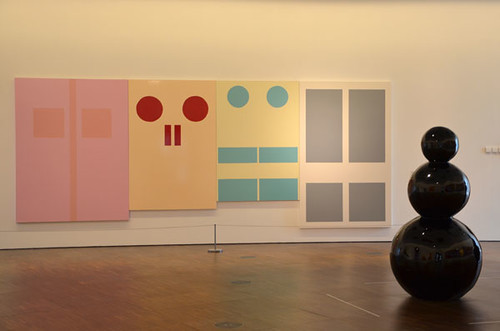
Until the early 2000s, Hume only created "door paintings." At first glance, the pieces appear to be minimalist paintings. They are conceptual works, realistic real-size recreations of doors in British hospitals – offering a good illustration of the artist's clever take on mainstream contemporary art trends. Even today, as Hume works with a broader range of subject matter, he continues to blur the boundaries between abstract and figurative, maintaining a critical stance where he remains on the borderline without belonging to either. Though Hume's works may appear abstract, they represent things observed in daily life. In his conceptual paintings, the object exists like an icon – a fixed symbol. When seeking out subjects for his work, Hume draws inspiration from things that evoke conflicting emotions. Hume created the American Tan series, including paintings, sculptures, and prints related to the American pastime of cheerleading. Although Hume was from England, he spent summers visiting upstate New York. Each of the works from the series sent mixed messages, different from each other while based on the same forms. American Tan III (7.7.31) is symbolic, the legs of the cheerleader are carefully formed as the person leaps or does splits or otherwise is posed indiscreetly. Hume used painted bronze for the sculpture, making the pompoms from pieces of sheet metal attached to the end of one of the limbs.
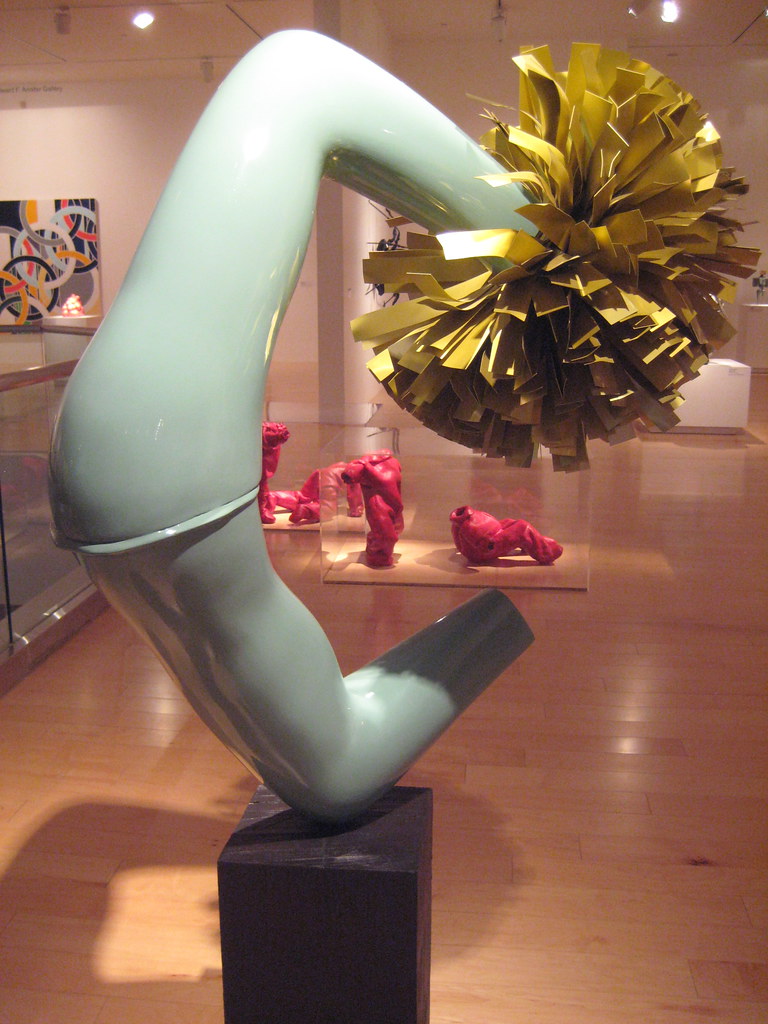
Rachel Whiteread
Rachel Whiteread (1963-) was born in Essex, England, her mother an artist and her father a teacher. Her first art education was at Cyprus College of Art, followed by the Slade School of Art, where she studied sculpture. Whiteread was part of the Young British Artists' second show, Sensation. Most of her works are based on ordinary objects she casts. Whiteread is known to make a cast of an existing chair or table, interested in the line and form the object creates. She constructs sculptures from small elements to entirely cast buildings. One of Whiteread's most famous works is the inside of a Victorian house cast in concrete. The cast objects become a replica of the original, forming ghostly representations. One of her major outdoor works is the Judenplatz Holocaust Memorial (7.7.32) in Vienna, a memorial for the 65,000 Austrians murdered in the Holocaust under the Nazi regime in World War II. On the outside, each row is a set of nameless books representing the people. The pages of the books are facing outwards, the spines of the book are inwards, and the identity of the titles unknown. The doors on the front are permanently closed and inside out without handles, the finality of the lives of the people killed. Incised on the broad concrete base are the names of the different concentration death camps where the people were sent for execution. There was some controversy about the appearance of the monument-it was not beautiful. At the unveiling, Simon Wiesenthal stated, "This monument shouldn't be beautiful; it must hurt."[10]
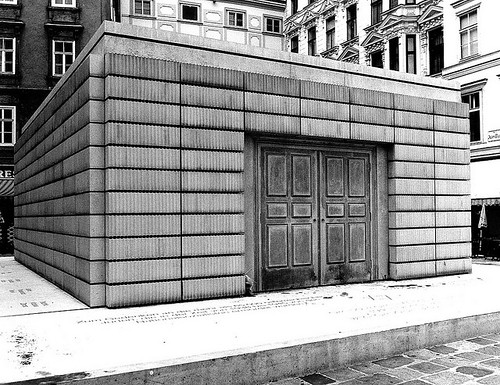
Embankment (7.7.33) was constructed from 14,000 translucent, white polyethylene boxes stacked in multiple formations. Some think they might be icebergs, with others believe they are stacked sugar cube villages. Whiteread became fascinated with boxes when she was cleaning out her mother's belongings. She filled different boxes with plaster for the installation and then stripped the actual box off, leaving the cast plaster box. Each box was unique with scars, torn sections, or even staples; all the blemishes showed in the plaster and remained. Next, she re-made the boxes with translucent polyethylene, a process she followed for thousands of boxes. The actual installation projected different and unusual feelings of space and scale. Some of the box stacks were exceptionally high; a dizzyingly view, other stacks allowed the viewer to touch them. Whiteread was also known for her casts of furniture.
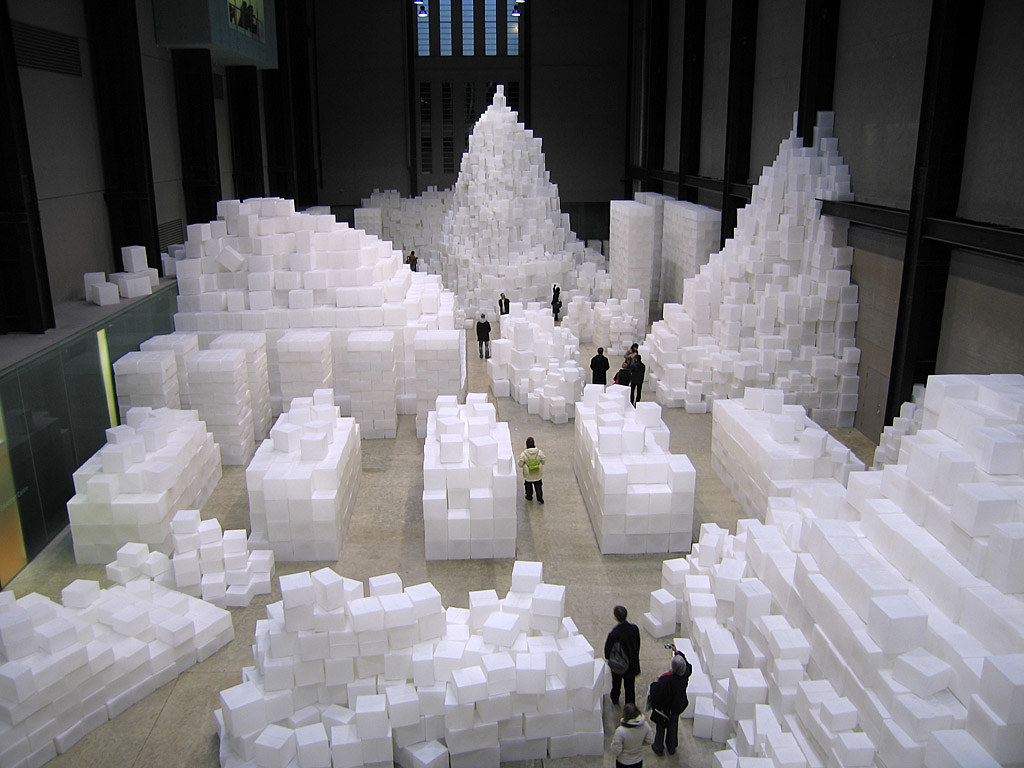
Untitled (100 Spaces) (7.7.34) is an exhibition composed of 100 resin casts of the undersides of different chairs. They are arranged in twenty rows, with five objects in each row. The pieces form a grid, the colors translucent. Art critic Craig Berry stated, "the sculpture oscillates between abstraction and reference. It shifts from being an accumulation of mute cubic forms to a shimmering index of everyday life."[11]
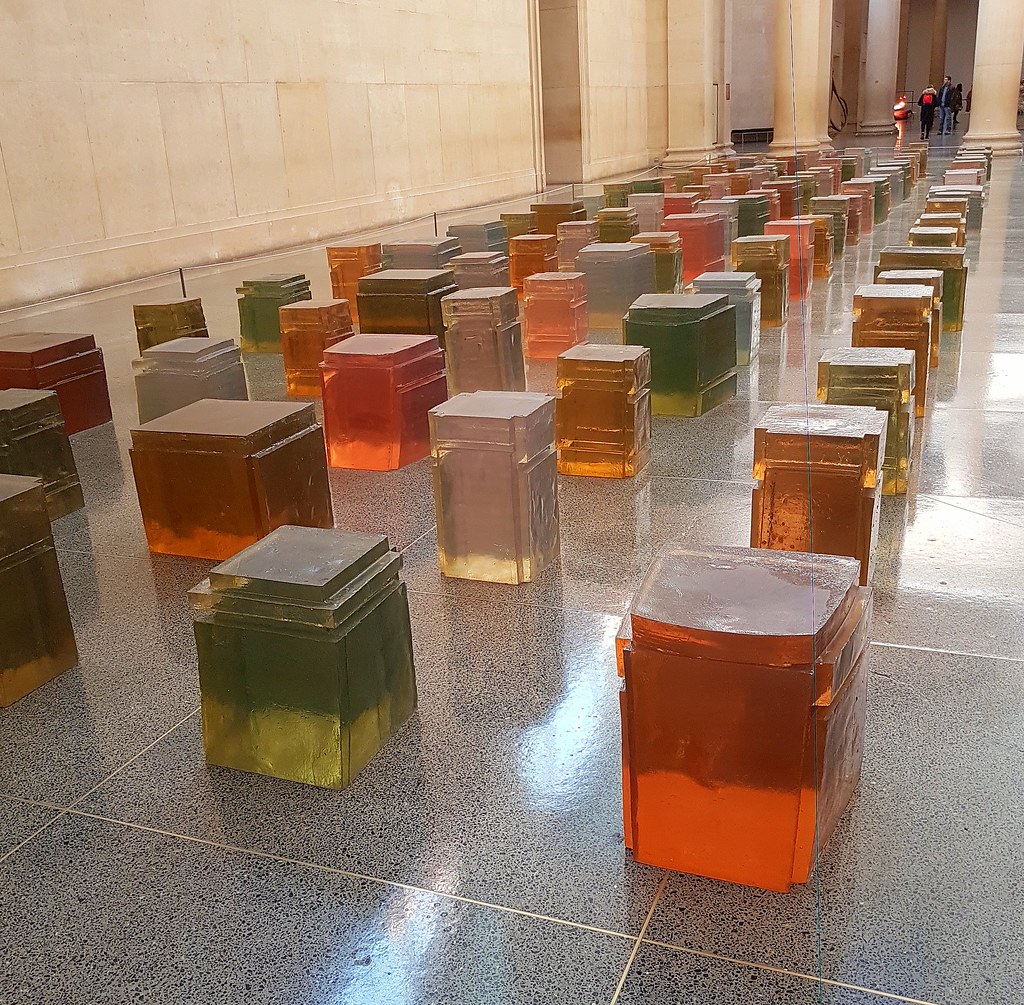 Figure \(\PageIndex{34}\): Untitled (100 Spaces) (1995, resin) CC BY-NC 2.0
Figure \(\PageIndex{34}\): Untitled (100 Spaces) (1995, resin) CC BY-NC 2.0
England was ready for a new art style when the Young British Artists held their first show, their work startling, provocative, and unusual, developing a new audience and an atmosphere for modern art. The success of their artwork led to the development of the Tate Modern and the Turner Prize. Today the Tate is an exceptionally successful modern art gallery, and the artists have continued to push the meaning of art.
[1] Retrieved from https://news.artnet.com/art-world/da...ur-beef-916097
[2] Retrieved from https://gagosian.com/artists/damien-hirst/
[3] Retrieved from https://www.theartstory.org/movement...itish-artists/
[4] Retrieved from https://www.jupiterartland.org/art/a...urs-out-of-me/
[5] Retrieved from https://www.theguardian.com/artandde...08/mar/31/art2
[6] Retrieved from https://www.theguardian.com/artandde...igallery.art10
[7] Retrieved from https://www.theguardian.com/artandde...-landy-art-bin
[8] Retrieved from https://www.sartle.com/artwork/princ...se-chris-ofili
[9] Retrieved from https://www.tate.org.uk/research/pub...ings-gary-hume
[10] Retrieved from https://www.theguardian.com/world/20...6/kateconnolly
[11] Retrieved from https://craigberry93.medium.com/rach...n-135c9482f024

